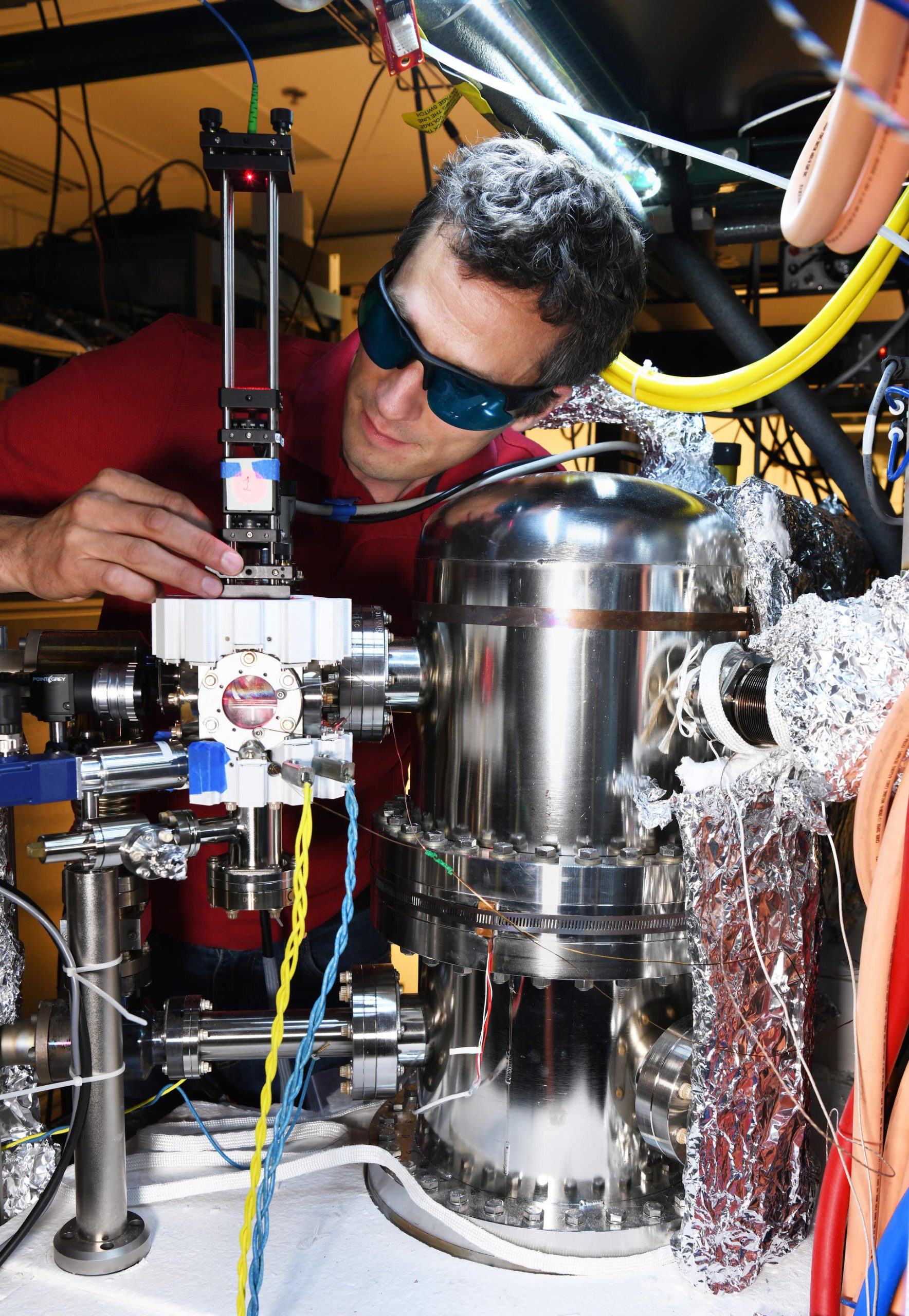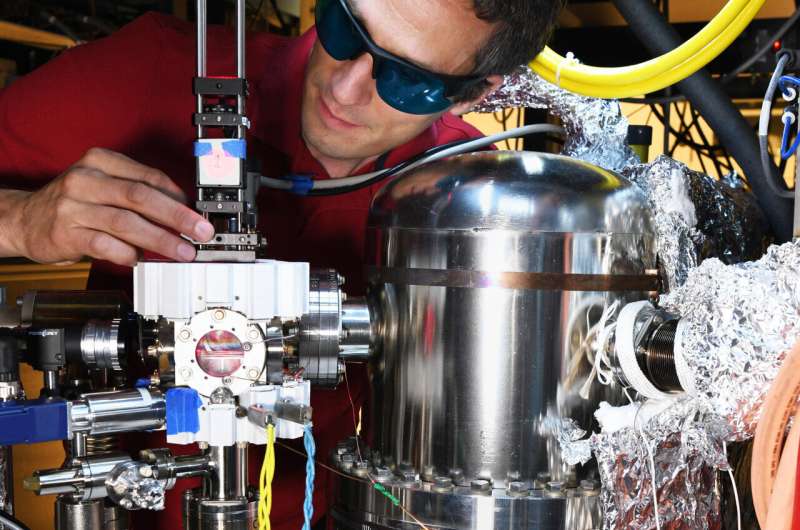

A novel, quantum-based vacuum gauge system invented by researchers at the National Institute of Standards and Technology (NIST) has passed its first test to be a true primary standard—that is, intrinsically accurate without the need for calibration.
Precision pressure measurement is of urgent interest to semiconductor fabricators who make their chips layer by layer in vacuum chambers operating at or below one hundred-billionth the pressure of air at sea level and must rigorously control that environment to ensure product quality.
“The next generations of semiconductor manufacturing, quantum technologies, and particle acceleration-type experiments will all require exquisite vacuum and the ability to measure it accurately,” said NIST senior project scientist Stephen Eckel.
Today, most commercial and research facilities use conventional high-vacuum sensors based on electrical current detected when rarefied gas molecules in a chamber are ionized (electrically charged) by an electron source. These ionization gauges can become unreliable over time and require periodic re-calibration. And they are not compatible with the new worldwide effort to base the International System of Units (SI) on fundamental, invariant constants and quantum phenomena.
NIST’s system, by contrast, gauges the amount of gas molecules (typically hydrogen) remaining in the vacuum chamber by measuring their effect on a microscopic cluster of trapped lithium atoms cooled to a few thousandths of a degree above absolute zero and illuminated by laser light. It does not need calibration because the interaction dynamics between lithium atoms and hydrogen molecules can be calculated exactly from first principles.
This portable cold-atom vacuum standard (pCAVS)—1.3 liters in volume excluding the laser system—can be readily attached to commercial vacuum chambers; a narrow channel connects the chamber interior to the pCAVS core. In a recent series of experiments, when the scientists connected two pCAVS units to the same chamber, both produced exactly the same measurements within their very small uncertainties.
The units were able to accurately measure pressures as low as 40 billionths of a pascal (Pa), the SI unit of pressure, within 2.6 percent. That’s about the same as the pressure surrounding the International Space Station. Atmospheric pressure at sea level is around 100,000 Pa.
“The portable cold atom vacuum standard has passed its first big test,” said Eckel. “If you build two presumably primary standards of any kind, the very first step is to make sure they agree with each other when they measure the same thing. If they disagree, they are clearly not standards.” Eckel and colleagues reported their results online on July 15 in the journal AVS Quantum Science.
In the pCAVS sensor core, vaporized ultracold lithium atoms are dispensed from a source and then immobilized in a chip-scale magneto-optical trap (MOT) designed and fabricated at NIST. Atoms entering the trap are slowed at the intersection of four laser beams: one input laser beam and three others reflected from a specially designed grating chip. The laser photons are tuned to exactly the right energy level to damp the atoms’ motion.
To confine them in the desired location, the MOT uses a spherical magnetic field produced by a surrounding array of six permanent neodymium magnets. The field strength is zero at the center and increases with distance outward. Atoms in higher-field areas are more susceptible to laser photons and are thus pushed inward.
After the lithium atoms are loaded into the MOT, the lasers are turned off and a small fraction of the atoms—about 10,000—are trapped solely by the magnetic field. After waiting for some period of time, the laser is turned back on. The laser light causes the atoms to fluoresce, and they are counted using a camera that measures the amount of light they produce: the more light, the more atoms in the trap and vice versa.
Every time a trapped lithium atom is struck by one of the few molecules moving around in the vacuum, the collision kicks the atom out of the magnetic trap. The faster the rate that atoms are ejected the trap, the more molecules are in the vacuum chamber.
One of the biggest cost drivers of a cold atom vacuum gauge is the number of lasers needed to cool and detect the atoms. To alleviate that problem, both pCAVS units receive light from the same laser through a fiber-optic switch, and they take measurements alternately. The scheme allows for as many as four units to be connected to the same laser source. For applications where multiple sensors are required, such as those at accelerator facilities or semiconductor manufacturing lines, such multiplexing of pCAVS sensors can lower the per-unit cost.
For the current experiment, the trapped atom clouds in the two pCAVSs were separated by 20 cm (about 8 inches) in direct line of sight to each other. As a result, the pressures at the two atom clouds were assumed to be identical. But when the team first used them to measure the vacuum pressure, the two gauges showed wildly different rates of atom loss.
“My heart sank,” said Eckel. “These are supposed to be vacuum standards, and when we turned them on, they couldn’t agree on the pressure of the vacuum chamber.” To try to determine the source of the discrepancy, the team interchanged components between the two units over multiple experiments. As they swapped components, the two pCAVSs continued to disagree—curiously, by exactly the same amount. “Finally, it just occurred to us: Maybe they are in fact at different pressures,” said Daniel Barker, one of the project scientists.
The only thing that could have caused them to be at different pressures is a leak, a small hole that could allow atmospheric gas into the vacuum. It had to be very small: The team had thoroughly checked for such leaks before turning on the pCAVSs. The team got the most sensitive leak detector they could find to do one final search and found that there was indeed a tiny pinhole leak in one of the glass windows of the pCAVS. After the leak was repaired, the two pCAVS agreed on their measurements.
Looking for discrepancies in the readings between multiple vacuum gauges is a method of leak detection often used in large scientific experiments including particle accelerators and gravity wave detectors such as LIGO.
The primary limitation on this technique, however, is that the calibration of most vacuum gauges can change with time. For that reason, it is often hard to distinguish a true leak from merely a drift in calibration. But because the pCAVS is primary gauge, there is no calibration and thus no calibration drift. Using three or more pCAVSs can help the next generation of accelerators and gravity wave detectors triangulate leaks in their large vacuum systems with greater accuracy.
The next steps in developing pCAVS is to validate its theoretical underpinning. In order to translate the loss rate of cold atoms from the magnetic trap into a pressure, quantum scattering calculations are required. “These calculations are rather complicated,” says Eite Tiesinga, who leads the theoretical effort, “but we believe that their calculations are good to a few percent.”
The ultimate test for the theory is to build a special vacuum chamber where a known pressure can be generated—called a dynamic expansion standard—and attach a pCAVS to measure that pressure. If the pCAVS and the dynamic expansion standard agree on the pressure, that is evidence that the theory is correct. “This next step in the process is already underway, and we expect to know if the theory is good very soon,” Eckel said.
A new way to measure nearly nothing: Ultracold trapped atoms to measure pressure
Lucas H. Ehinger et al, Comparison of two multiplexed portable cold-atom vacuum standards, AVS Quantum Science (2022). DOI: 10.1116/5.0095011
National Institute of Standards and Technology
Citation:
A primary standard for measuring vacuum (2022, July 15)
retrieved 15 July 2022
from https://phys.org/news/2022-07-primary-standard-vacuum.html
This document is subject to copyright. Apart from any fair dealing for the purpose of private study or research, no
part may be reproduced without the written permission. The content is provided for information purposes only.